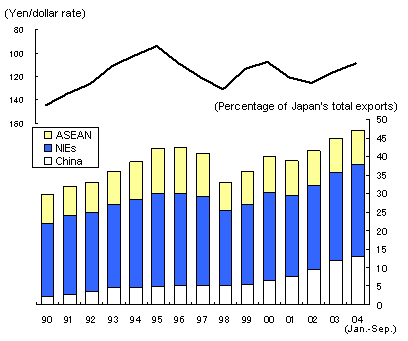With the yen's sharp rise against the dollar, fears are mounting that exports to China, which have so far been brisk, will slow and put the brakes on Japan's economic recovery. However, reflecting China's role as a production base - importing parts from Japan and exporting processed goods - when the yen strengthens against the dollar, the competitiveness of China, which has effectively pegged its currency to the greenback, also rises. Thus, the resulting increase in China's exports (especially U.S.-bound exports) also helps boost Japan's exports to China.
The trade relationship between Japan and China is similar to that between Japan and other Asian economies such as the newly industrialized economies (NIEs) and the Association of Southeast Asian Nations (ASEAN). In fact, contrary to textbook theory, Japan's exports to Asia accelerate when the yen strengthens and lose steam when it weakens. Japan's exports to Asia are surging despite the rise in the yen that began in 2002, just as they did during previous rounds of yen appreciation in 1995 and in 2000. In contrast, during periods of a weakening yen, such as 1997-1998 and 2001-2002, Japan's Asia-bound exports fell.
This relationship between the yen-dollar rate and Japan's exports to Asia can be explained as follows: First, the yen's rise against the dollar boosts exports from Asia as the region receives more direct investment from Japan and their competitiveness improves against Japanese products. Through this "income effect" Asia's imports from Japan (Japan's exports to Asia) also increase. On the negative side, a strong yen is expected to dampen Japan's exports which are becoming more expensive. However, because Japanese exports to Asia are largely made up of capital and intermediate goods such as key components that are difficult to procure in other Asian countries, the price effect tends to be minor. Thus, when the income and price effects are considered together, we see that a strong yen boosts Japan's exports to Asia. Symmetrically, when the yen weakens, Japan's exports to Asia drop because Asian economies also slow down. The rapid fall in the yen between 1996 and 1998 in particular was one trigger for the Asian currency crisis, and was accompanied by a plunge in Japan's exports to Asia as economic growth in those countries slowed down.
In contrast to Asia, in other countries and regions such as the U.S. and Europe, their production is not affected to as great an extent by fluctuations in the yen-dollar rate. Because the price elasticity of imports from Japan is relatively high, and the price effect suppresses imports from Japan when the yen is strong, Japan's exports to Europe and the U.S. tend to fall when the yen strengthens. Reflecting this sharp contrast between Japan's exports to Asia and those to other regions, we see that Japan's dependence on Asia-bound exports (as shown by Asia's share of Japan's total exports) increases when the yen strengthens and falls when the yen weakens ( diagram ). When the yen rises, Japan's U.S.-bound exports in particular lose steam, but because its exports to Asia increase, the decline in overall exports is relatively small. And when the yen weakens against the dollar, the increase in exports to the U.S. is offset to some extent by a decline in exports to Asia; so the pace of overall export growth remains relatively modest. In this way, Japan's exports to Asia serve as a built-in stabilizer that eases the effects of exchange rate fluctuations on the Japanese economy.
In the 1980s, this phenomenon owed largely to changes in exports to the NIEs. However, since the 1990s, in line with the shift in direct investment to ASEAN and then China, it has become apparent that exports to ASEAN and China also serve to cushion the effects of exchange rate fluctuations on Japan. Particularly China, which has become known as the "world's workshop," is heavily dependent on Japan in terms of imports of capital and intermediate goods, while at the same time increasing its share of the global export market. As a result, just as in the case of the NIEs, a rise in China's exports due to a strong yen also triggers greater imports from Japan. Thus, in a sense, Japan's exports to China are growing not despite the strong yen but because of it.
Of course, a good part of these increased Japanese exports to China attributable to the strong yen are actually bound for the U.S. via China; such exports cannot completely offset the negative effects of a stronger currency on total exports from Japan. Fortunately, in addition to export growth, strong domestic demand centering on investment is also boosting China's imports from Japan. Because China is becoming more important to Japanese companies, not only as a production base but also as a market for finished products, the shift in Japan's exports from other markets to China will likely continue over the long term.

(Note)ASEAN here is Indonesia, Malaysia, the Phlippines and Thailand
(Source)Japanese trade statistics.


